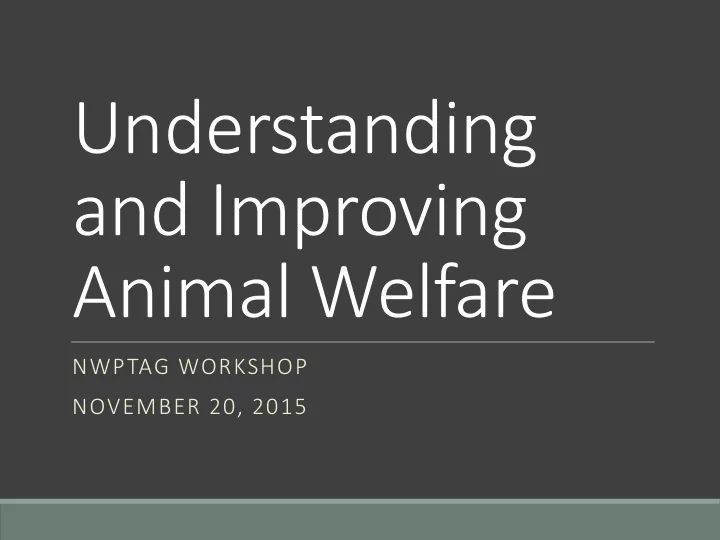

Understanding and Improving Animal Welfare NWPTAG WORKSHOP NOVEMBER 20, 2015
What is Animal Welfare? Animal Welfare refers to an animal’s collective physical, mental, and emotional states over a period of time, and is measured on a continuum from good to poor. AZA Animal Welfare Committee
What is Animal Welfare? An animal typically experiences good welfare when healthy, comfortable, well-nourished, safe, able to develop and express species-typical relationships, behaviors, and cognitive abilities, and not suffering from unpleasant states such as pain, fear, or distress. Because physical, mental, and emotional states may be dependent on one another and can vary from day to day, it is important to consider these states in combination with one another over time to provide an assessment of an animal’s overall welfare status.
Animal Welfare Ranges on a Continuum From poor to excellent Can change at any time based on environmental, health or psychological factors We want to create a situation where animals not only experience good welfare, but thrive. Excellent welfare Poor welfare
Impacts of Captivity Perhaps the greatest stressor in populations of captive animals are those over which the animal has no control and from which they cannot escape
While many environmental enrichment strategies have undoubtedly improved the conditions of captivity ( Bloomsmith and Else, 2005; Kuehn, 2002; Sorensen et al., 2004; Swaisgood et al., 2001 ), they have tended to underemphasize the influence of artificial environments on the sensory behavior of captive animals.
Abiotic Environmental Factors Sensory Environment ◦ Sound ◦ Visual ◦ Smell ◦ Taste ◦ Tactile ◦ Thermal
Confinement Specific Factors Restricted movement Inability to retreat or hide effectively Routine husbandry Restricted feeding and foraging Unusual social groupings Forced proximity to humans/predators/competitors Limited choices/control/predictability
Ways animals perceive humans 1. Predator-Prey Relationship 1. Food (Prey) 2. Enemy (Predator) 2. Irrelevant part of the environment 3. Another animal: may be heterospecific or conspecific, familiar or unfamiliar 1. Source of stimulation 2. Friend 3. Mate 4. Competitor
Personality Differences Personality is “behavioral differences across individuals that are consistent over time and across contexts or situations”. Variation along five dimensions: ◦ shyness - boldness ◦ exploration – avoidance ◦ activity ◦ sociability ◦ aggressiveness Watters and Powell (2012)
Keeper Animal Relationships Animal keepers are an important element of each animal’s environment, and the quality of the relationships between animal and keeper has an impact on the welfare of the animal. It is important to understand which aspects of these relationships influence individual well-being and careful consideration should be given to how individuals are affected by them. 12
Effects of Visitor Behavior Zoo visitors can be a source of stress, a source of enrichment, or neutral for animals (Hosey, 2000). Whether zoo visitors cause stress depends on: ◦ Species tendencies or individual personalities ◦ How animals are presented ◦ Behavior of visitors interacting with animals
Building Relationships Robust literature that the presence of people in zoos changes animal behavior Animals do seem to start with a natural wariness of people (the degree of which may vary by species). Fear may be reduced through increased neutral or positive experience. Fear can be increased through interactions with negative consequences. Many animals are able to discriminate between different categories of people (familiar and unfamiliar keeper, veterinarian, visitors). Animals establish a generalized relationship with unfamiliar people (the zoo visitor).
Reducing Fear Through Training
Unstructured Interactions “For many species human contact can, to a degree, substitute for contact with conspecifics.” - Young (2003) Environmental Pizzutto et al. (2007) Enrichment for Captive Animals Baker (2004)
Changing Visitor Behavior Signage Education about the effects of auditory and visual stress on animals Fernandez et al. (2009)
Changing Exhibit Design Retreats (Anderson et al., 2002) Visual barriers (Blaney and Wells, 2004) Control crowd numbers
Positive Relationships Control over interactions with people Participation in training Early and frequent positive interactions Let the animal manage its exposure and proximity via retreat or hiding places. Visitor education Increased amount of time keepers spend with animals especially in structured activities like PRT One keeper vs lots of keepers
Choice, Control, and Predictability The greatest stressor in captive animals is the inability to exert meaningful choice and control.
Important Problems to Solve Social ◦ Mates ◦ Companions ◦ To be or not to be? Environmental ◦ Space ◦ Access ◦ Food ◦ Features available to express behavioral needs
What can choice tell us about welfare? Preference testing ◦ Social- big brown bats (Kilgour et al 2013) ◦ Nutritional- slender lorises (Clayton and Glander 2010) ◦ Will animals make healthy choices? Consumer demand ◦ Lever pressing, chain pulling, etc.. ◦ Operant conditioning ◦ Food is usually the standard for motivational strength; primates will work just as hard for social companionship .
What are relevant choices for different animals? Mammals Birds Reptiles/Amphibians Fish
What can we do to increase choice and control for animals? Positive reinforcement training Environmental enrichment Cognitive challenges Unstructured human relationships Natural social groupings Habitat design
How can we give animals choices about mates? Choice tests Personality testing
Choices about social companions? Fission-fusion management Human relationships Common areas and private spaces Preference testing Mixed species groups
How can we provide more challenge/choice in food acquisition? Scatter feeding Puzzle feeders Choice tests Operant tasks
Choices in the physical environment? Responsive environments Toys, objects to manipulate, novel items Hiding places, refuges Exhibit rotation
What are some of the consequences of lack of choice/control? Learned helplessness Elevated or chronic stress Boredom Reproductive failure Abnormal behavior
Recommend
More recommend